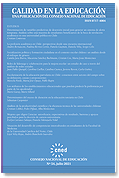Roles de liderazgo y colaboración para la mejora escolar: un estudio de caso a través del análisis de redes sociales.
DOI:
https://doi.org/10.31619/caledu.n54.952Palabras clave:
liderazgo educacional, colaboración, docentes, directivos, mejora escolar, análisis de redes socialesResumen
El liderazgo educativo se ha convertido en un elemento indispensable para promover la mejora escolar. Sin embargo, considerando los avances internacionales, poco se sabe acerca de cómo detectar y visualizar el liderazgo entre los actores educativos, sean docentes o directivos, en establecimientos chilenos. La siguiente investigación aborda esta brecha, utilizando el Análisis de Redes Sociales (ARS) para examinar las interacciones de prácticas colaborativas en los procesos de enseñanza y mejora, y determinar los roles y patrones de liderazgo. Para ello se utilizó un cuestionario referido a los actores educativos de un establecimiento escolar chileno que posee trayectoria de mejora en SIMCE y otras métricas. Basado en indicadores de centralidad del equipo docente y directivo, la densidad de interacciones del establecimiento, junto con la visualización de sus sociogramas o mapas de red, este estudio se enfoca en detectar qué actores educativos se ubican efectivamente en posiciones de liderazgo. Se encuentra que aquellos relacionados con el Programa de Integración Escolar (PIE) tienen un rol preponderante, en los que la pandemia covid-19 se presenta como un escenario que resalta este papel, más allá de las jerarquías existentes. Lo anterior entrega evidencia contextualizada para las prácticas educativas y procesos de mejora escolar.
Descargas
Publicado
Número
Sección
Licencia
Los autores conservan sus derechos de Copyright, sólo transfiere una parte de ellos a la revista aceptando los siguientes términos:
a.Los autores/as conservarán sus derechos de autor y garantizarán a la revista el derecho de primera publicación de su obra, el cual estará simultáneamente sujeto a la Licencia de reconocimiento de Creative Commons que permite a terceros compartir la obra siempre que se indique su autor y su primera publicación esta revista.
b. Los autores/as podrán adoptar otros acuerdos de licencia no exclusiva de distribución de la versión de la obra publicada (p. ej.: depositarla en un archivo telemático institucional o publicarla en un volumen monográfico) siempre que se indique la publicación inicial en esta revista.
c. Se permite y recomienda a los autores/as difundir su obra a través de Internet (p. ej.: en archivos telemáticos institucionales o en su página web) antes y durante el proceso de envío, lo cual puede producir intercambios interesantes y aumentar las citas de la obra publicada.
